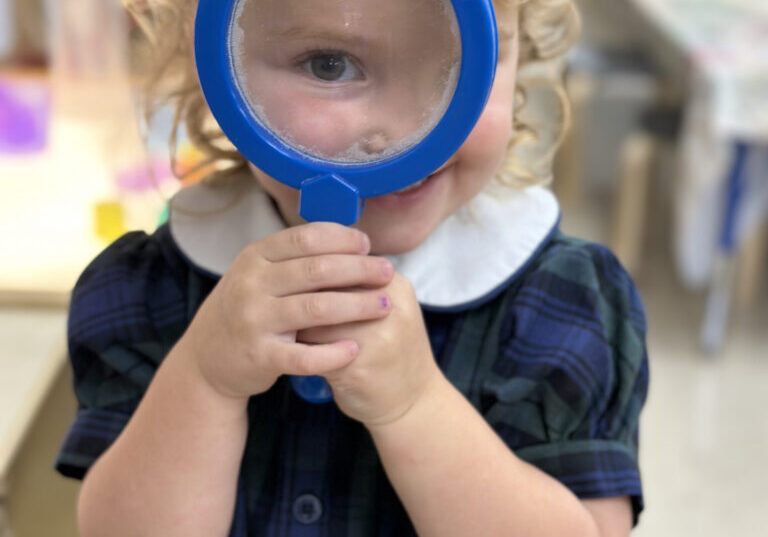Walk into Trinity’s Wonder Lab and you’ll immediately understand why longtime teacher Amy McRae calls it “the happiest place on campus.” There’s something magical about watching a four-year-old’s face light up as they figure out exactly the right angle to send a marble racing down a ramp, or seeing the intense concentration of a child carefully pouring colored water from cup to cup at the light table.
This isn’t your typical classroom. Part art studio, part sensory playground, part science lab—the Wonder Lab is where Trinity’s youngest learners get to say yes to their biggest ideas and dive headfirst into discovery.
“I love watching them come in here,” Amy says with a smile. “They walk through that door, and you can just see their whole body language change. They know this is their space to explore and create and get messy.”
Here’s how this one-of-a-kind space helps our youngest students grow in ways that will shape them for years to come.
Learning That Feels Like Discovery
In the Wonder Lab, the line between play and education disappears completely. While kids think they’re just having fun building block towers or creating underwater worlds, they’re actually developing critical early skills.
“When I see a child experimenting with magnets—testing what sticks, what doesn’t, figuring out how to make a chain—they’re doing real science,” Amy explains. “They’re forming hypotheses, testing them out, learning from what happens. But to them? They’re just playing with cool stuff.”
The beauty is in the choice. Kids can spend twenty minutes at the sensory table running their hands through rice and beans, working on fine motor skills and self-regulation. Or they might gravitate toward the building area, where spatial reasoning and problem-solving happen naturally as they figure out how to make their tower stay up.
Weekly themes often tie into what’s happening around school. During the Blessing of the Pets, the Wonder Lab transforms into a bustling “Pet Vet” clinic. Kids paint portraits of their furry friends, set up examination tables for stuffed patients, and practice the kind of caring, nurturing play that builds empathy right alongside their imagination.
“You should see them with their ‘patients,'” Amy laughs. “They’re so gentle and serious about taking good care of them. That’s social-emotional learning in action.”
Bringing Families Into the Magic
One of Amy’s favorite parts of running the Wonder Lab? Sharing those special moments with families back home.
She captures the everyday magic—kids deep in concentration at the light table, the triumphant grin when someone finally gets their marble run working, friends collaborating on a massive block city. These photos and short videos make their way to parents, offering a window into their child’s daily discoveries.
“Parents text me back all the time,” Amy says. “‘I had no idea she loved building so much!’ or ‘He’s been talking about that marble experiment all week!’ Those little glimpses remind them that so much learning is happening, even when it just looks like play.”
It’s more than just cute photos, though. These snapshots help families understand what their children are drawn to, what challenges them, what brings them joy. They bridge the gap between school and home in a way that strengthens the whole community.
Growing Future Artists and Confident Creators
The Wonder Lab naturally flows into Trinity’s art program, creating a pathway for young creators to grow year after year. The youngest students start with pure process art—exploring what happens when colors mix, how paint feels on paper, what textures they can create with different tools.
As they get older, their projects become more intentional while keeping that sense of joy and exploration. They study famous artists, learn new techniques, even collaborate on community projects that connect their learning to the wider world.
“I love watching a kindergartener who was finger painting in the Wonder Lab as a three-year-old suddenly tackle a self-portrait with such confidence,” Amy reflects. “They know they’re artists because we’ve been telling them—and showing them—that they are from the very beginning.”
The annual Art Show brings this full circle, with students contributing a self-portrait to a massive display. Walking through that gallery, seeing hundreds of faces painted with such individual style and personality, you get a real sense of who these kids are becoming.
“It’s incredible to see all those faces together,” Amy says, her voice getting a little emotional. “Each one so different, but all of them saying ‘This is me. This is who I am.’ That’s what we’re really building here—confident, creative human beings.”
Why Wonder Matters
Here’s the thing about the Wonder Lab that Amy wants every parent to understand: this isn’t just about learning to paint or mastering scissors or figuring out how magnets work. It’s about something much bigger.
“These early experiences—when children feel safe to try new things, to make mistakes, to follow their curiosity wherever it leads—that shapes how they approach everything for the rest of their lives,” she explains. “Are they willing to take creative risks? Do they see themselves as capable problem-solvers? Do they trust their own ideas? That all starts here.”
In a world that can feel rushed and academic-focused, the Wonder Lab stands as a reminder that joy and learning aren’t opposites—they’re partners. When children feel truly seen and supported in their natural curiosity, amazing things happen.
At Trinity, we believe learning should begin with wonder. And in Amy’s magical space, that’s exactly where every adventure starts.
Curious to see your child’s wonder come alive? Schedule a visit and discover how Trinity nurtures young learners through joy, discovery, and the kind of hands-on exploration that builds confident, creative thinkers for life.


